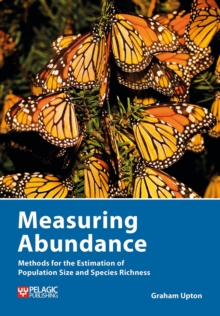Description
| Product ID: | 9781784272319 |
| Product Form: | Paperback / softback |
| Country of Manufacture: | GB |
| Series: | Data in the Wild |
| Title: | Measuring Abundance |
| Subtitle: | Methods for the Estimation of Population Size and Species Richness |
| Authors: | Author: Graham Upton |
| Page Count: | 229 |
| Subjects: | Probability and statistics, Probability & statistics, Ecological science, the Biosphere, Zoology and animal sciences, Spreadsheet software, Data capture and analysis, Ecological science, the Biosphere, Animal ecology, Excel, Data capture & analysis |
| Description: | Measuring the abundance of individuals and the diversity of species are core components of most ecological research projects and conservation monitoring. This book brings together in one place the methods used to estimate the abundance of individuals in nature. Code and examples for use with the R programming language are included. Measuring the abundance of individuals and the diversity of species are core components of most ecological research projects and conservation monitoring. This book brings together in one place, for the first time, the methods used to estimate the abundance of individuals in nature. The statistical basis of each method is detailed along with practical considerations for survey design and data collection. Methods are illustrated using data ranging from Alaskan shrubs to Yellowstone grizzly bears, not forgetting Costa Rican ants and Prince Edward Island lobsters. Where necessary, example code for use with the open source software R is supplied. When appropriate, reference is made to other widely used programs. After opening with a brief synopsis of relevant statistical methods, the first section deals with the abundance of stationary items such as trees, shrubs, coral, etc. Following a discussion of the use of quadrats and transects in the contexts of forestry sampling and the assessment of plant cover, there are chapters addressing line-intercept sampling, the use of nearest-neighbour distances, and variable sized plots. The second section deals with individuals that move, such as birds, mammals, reptiles, fish, etc. Approaches discussed include double-observer sampling, removal sampling, capture-recapture methods and distance sampling. The final section deals with the measurement of species richness; species diversity; species-abundance distributions; and other aspects of diversity such as evenness, similarity, turnover and rarity. This is an essential reference for anyone involved in advanced undergraduate or postgraduate ecological research and teaching, or those planning and carrying out data analysis as part of conservation survey and monitoring programmes. |
| Imprint Name: | Pelagic Publishing |
| Publisher Name: | Pelagic Publishing |
| Country of Publication: | GB |
| Publishing Date: | 2020-10-12 |


